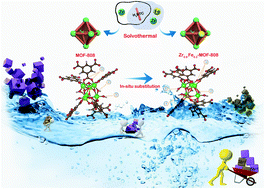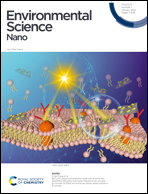Insights into the binding manners of an Fe doped MOF-808 in high-performance adsorption: a case of antimony adsorption†
Abstract
The full utilization of adsorption sites is crucial for adsorption technology. Metal–organic frameworks (MOFs), which are hotspot materials in environmental remediation, are not satisfactory in many cases because of their high specific surface area and relatively low adsorption capacity. In this work, a series of zirconium–iron bimetallic MOFs (ZrxFe(1−x)-MOF-808) was prepared. The optimal material (Zr0.8Fe0.2-MOF-808) possesses superb adsorption capacities of 524 and 310 mg g−1 for antimonate and antimonite, respectively. The carboxyl and hydroxyl groups were identified as the main adsorption sites by FTIR and XPS. The role of Fe in the adsorption process of Zr0.8Fe0.2-MOF-808 was further explored by DFT simulations, and four binding manners were discovered, consistent with the adsorption capacity data. Subsequently, application potential tests proved that the Zr0.8Fe0.2-MOF-808 shows good anti-interference ability, wide pH adaptability, and recyclability. Overall, this high-performance bimetallic MOF has been analyzed from the macrocosmic to the microcosmic, which provides certain support for the development of MOF modifications.

- This article is part of the themed collection: Nanomaterial applications in water


 Please wait while we load your content...
Please wait while we load your content...